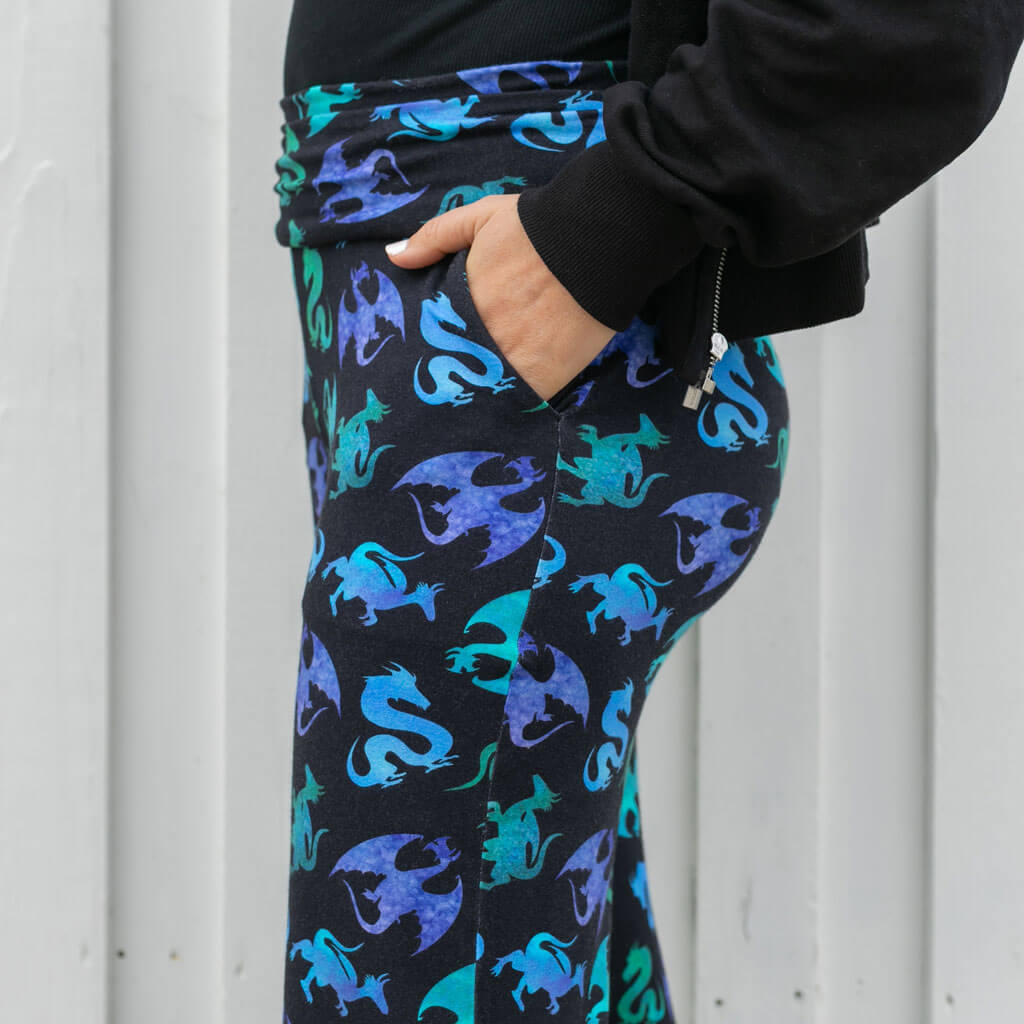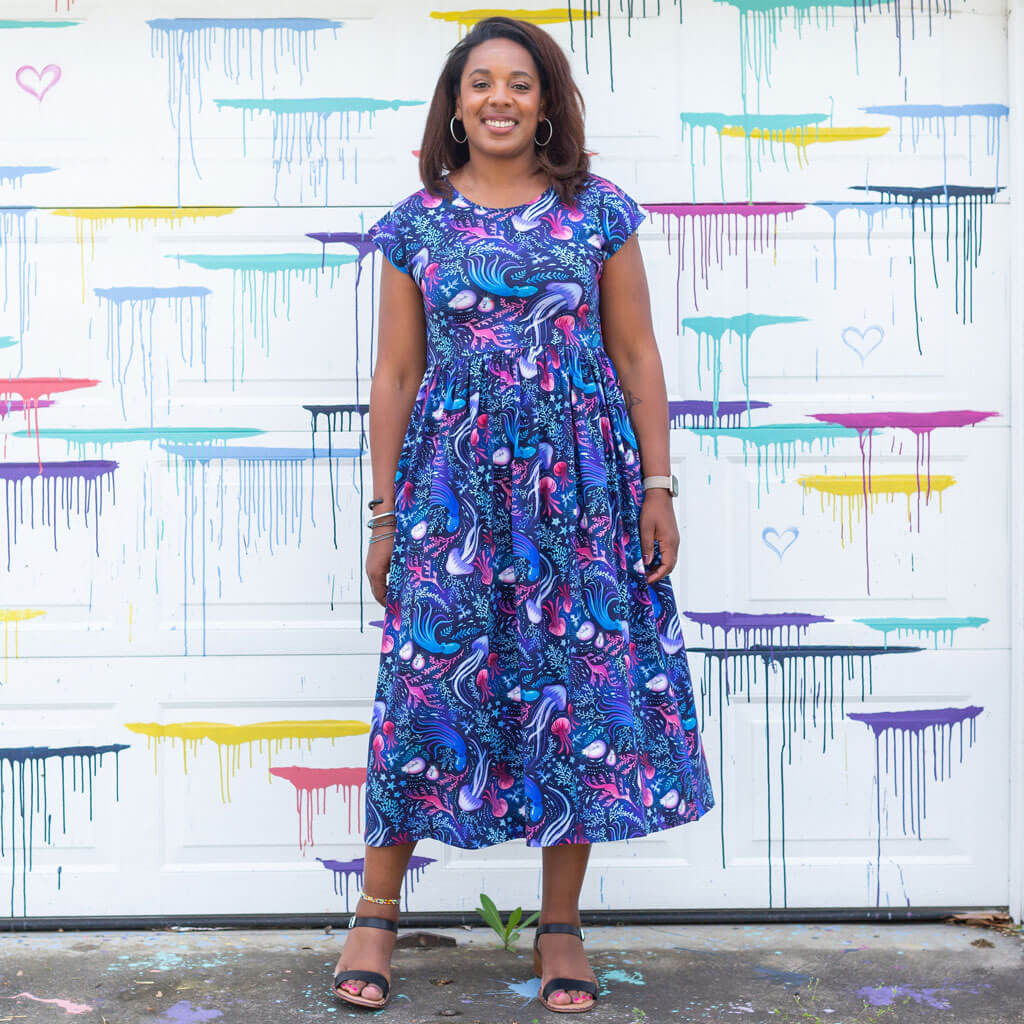Shop Now
New
Sale
Introducing the 13,230 Digits of Pi Collection!
January 28, 2022 6 min read 1 Comment
They're here! The fabulous 13,230 Digits of Pi dresses and shirts are available now!

What, Why, How
I had this “brilliant” idea to create a Pi design that would feature as many handwritten digits as I could fit into the maximum size rotary screen textile printer (72” by 34”). I had figured each number would be about 3” tall, so I would be able to fit about 1200 of them, nicely spaced, on the fabric.

But the mockup on the size 6 dress showed that 3” numerals were way too big. I could only fit about 8 rows of digits on the size 6, which meant the size 2T would have about 3 rows. There was also way too much white space. No good.

In fact, even 1.5” numerals were still too big! So I reduced them to about .75” and tightened the spacing, and it finally looked right. However, this meant that instead of about 1200 digits of pi, I would need more than 10,000. That’s ok, I thought (naively). How much work could it be to write out 10,000 digits?
Undaunted, I used my computer’s screen reader program to have the the digits read aloud to me while I wrote them longhand on plain white paper with a red sharpie. I had to reduce the reader’s speed to 10% so that I could follow the voice accurately. It sounded pretty funny:
Then I digitized the writing by taking photos of the sheets and converting them to vector art in Illustrator.


And then I started arranging them in (sort of) neat rows, and then pulling each number set (all the 1’s, all the 2’s etc) onto their own separate layers to colorize them. I also discovered that (not surprisingly) as I wrote, my handwriting changed size and shape, so I had to resize some of it to make it fit properly in rows.

Out of habit, I also turn the pen every so often, something I have always done when writing with a pencil to keep the tip sharp. I do it with every stylus I use (even, pointlessly, my Apple Pencil). Anyway, it meant that some numbers came out fat and some came out skinny.

The good news was that this was exactly the kind of look that I wanted the art to have - most of the numbers looked unique and it did look like someone had sat there writing out the digits of pi by hand (because I had!) with different colored sharpies (I chose a different color for each digit, something that is fairly easy to do in Adobe Illustrator).
The bad news was that it took me 5 hours to do 3 lines - 1.5” out of 72”.
Clearly this was not going to work. If I wanted to finish this art by Christmas, or by the actual deadline (September 1), I was going to have to use another method.
When I was in college, I studied the paleography of medieval manuscripts and started working with the Richard Rufus Project. Professor Wood taught me to read Latin philosophical texts and to assist in collating the works (reading the manuscripts and comparing them to the critical edition she was preparing). I learned that every scribe’s writing contains multiple ways of forming the same letters, but after a while you learn to read “the hand.” There are only so many ways of writing the letter p, or even its variations when used for abbreviations for words such as pro, per, propter etc.

I had already written 1000 digits. Since Pi has a fairly even distribution of numbers (about 90-110 of each numeral in the first 1000 digits), I had about 100 different examples of each numeral in my handwriting, and I figured that was enough for a representative sample.
So instead of continuing to write, I copied the numerals I already had. Then I visited 1 Million Digits of Pi, copied the next ~14,000 digits into Notepad, divided them into groups of 5, and printed out 20 pages of digits. And then I painstakingly rearranged the digits into the correct order, all the way through to digit #13230 (it’s a 7).

This went much faster than the handwriting method, but it still took me another 15 hours to finish.
As I worked, I enjoyed finding little familiarities, like zip codes and famous number sequences (24601!), and I marveled that my own zip code never came up - in fact, very few sequences of more than 4 numbers repeated. I particularly loved the funny section with six 9's in a row. And I thought often about the scale of what I was working on. My mind could barely comprehend thousandths - just the first three digits of Pi - 3.141. By the time I finished, the enormity (minisculity?) of the number I was copying gave me a new appreciation for Pi, its mystery, its profundity (life, the universe, and everything!).

The next step, of course, was figuring out how to copyedit this thing. I was totally sure I had made at least a few homeoteleutons, like my medieval forbears. So, Rebecca and I sent out a call to our fabulous Princess Awesome customers to see if anyone (besides us) thought it might be fun to read a line from the Pi Digits design and check to make sure it was accurate.
Not surprisingly, SO MANY folks wanted to help! Parents and kids worked together, couples read aloud to each other, folks used screen readers like I had, and one person invented an (ingenious) method of re-typing the numbers into the search bar of their browser with the 1 Million Digits of Pi page open - like spell checker for Pi! So smart!!
After double checking every line (yes, we asked two people at least to read each line, independently of each other), and correcting the mistakes (only one homeoteleuton - I was so proud), it was time to send the Pi Digits design to the factory.
How is fabric printed? It's so interesting! Basically, we use a series of stencils. First, imagine each color as its own big stencil. So if we want to print something that looks like this:

We would need a stencil cut like this for all the pink nines:

and one like this for all the purple eights:

and one like this for all the red zeroes:

and so forth, one for each color.
When a factory actually cuts the screens, they use huge sheets of flat metal that are then rolled up into cylinders and placed onto the printing machine. You can watch some of our other designs being printed here:
Once the fabric is finished, we cut out the pieces that turn into your clothes! Because we are making about 1,000 dresses or shirts at a time, the factory uses software to plan out how to cut the pieces in the most efficient way possible. They make a digital layout of the pieces (called a "marker") on top of all those layers of fabric and they use a saw (yes, a rotary saw, just like your circular saw except smaller) and they cut through all the layers at once, ending up with a whole ton of pieces that are then sewn together as your clothes.
Here's a (really, really terrible) mockup of what a marker could look like:

Now check out what it looks like when the marker is on top of the fabric:

You can see that there is almost always some fabric left over on every edge, which means that the design at the edges will probably never show up on anyone's clothes. It also means that depending on which pieces happen to be sewn together, a piece of clothing could get a repeating section (the same random place could end up on both the front and the back of the dress, for example). It all depends on how the fabric is laid out and which marker ends up on top of it.
Really neat, right?! It's so interesting to see just how the fabric works with the pieces of the garments and how different parts of the design end up on different places in the clothing. What will you find when you take a good look at your unique Pi Digits dress? Will you find your zip code, your phone number, birthday, or another special date? Will you be super lucky and find it twice (on two different parts of the garment)?
We hope you have as much fun wearing and enjoying this design as we had in making it!
1 Response
Leave a comment
Comments will be approved before showing up.
Subscribe
Sign up to get the latest on sales, new releases and more …






Catherine
February 01, 2022
Love the math designs in your collections! More would be wonderful.